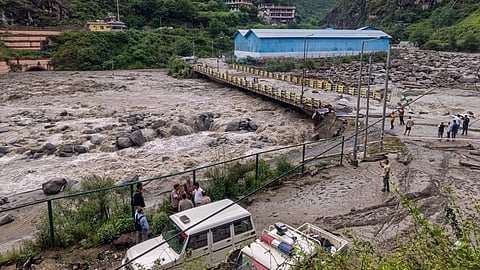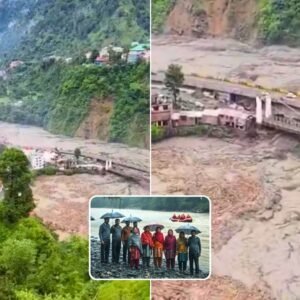Devastating flash floods along the Ravi River have unleashed chaos across Himachal Pradesh, leaving communities trapped and infrastructure severely damaged. The sudden surge of water caught residents completely off guard during what seemed like ordinary monsoon conditions. Emergency teams work around the clock to reach isolated areas where hundreds remain stranded without basic supplies.
Understanding the Scale of This Natural Disaster
The widespread destruction across multiple districts has overwhelmed local emergency response capabilities throughout the affected regions. Rising water levels destroyed homes, roads, and bridges within hours of the initial flood surge beginning. Villages that stood for generations now lie partially submerged under murky floodwater containing debris and sediment.
Meteorological reports indicate unprecedented rainfall amounts triggered these catastrophic flood conditions across the mountain state. The Ravi River system, normally manageable during the monsoon season, became a raging torrent that swept away everything in its path. Weather stations recorded rainfall levels exceeding normal monsoon averages by more than 300 per cent in some areas.
Emergency services report that communication networks remain severely compromised across many flood-affected districts and remote villages. Power lines lie damaged or completely destroyed, leaving thousands without electricity for basic needs and emergency communications.
Rescue Operations Face Unprecedented Challenges
Helicopter rescue missions encounter dangerous flying conditions due to persistent heavy rainfall and dense cloud formations. Ground rescue teams struggle to reach remote areas where roads have been washed away completely. The mountainous terrain makes alternative access routes extremely difficult to establish quickly.
Military personnel have joined civilian rescue efforts using specialised equipment designed for disaster response operations. Navy divers assist in water rescue operations while Army engineers work to restore basic infrastructure connections. Air force helicopters provide the primary means of reaching completely isolated mountain communities.
Key rescue priorities include:
- Evacuating families trapped in partially collapsed buildings
- Delivering emergency medical supplies to isolated health centres
- Establishing temporary communication networks for coordination efforts
- Providing clean drinking water to communities cut off from supplies
- Airlifting critically injured victims to major hospital facilities
Search and rescue teams report finding survivors in unexpected locations where they sought shelter during the initial flood surge. Many residents climbed to higher floors or rooftops to escape rising water levels throughout the night.
Impact on Local Communities and Infrastructure
The economic impact extends far beyond immediate flood damage as agricultural lands face complete crop destruction. Farmers who depended on seasonal harvests now confront total financial losses with limited insurance coverage available. Livestock losses also represent significant economic hardship for rural families dependent on animal husbandry.
Tourist areas that normally generate substantial revenue during peak season now face months of reconstruction before reopening. Hotels, restaurants, and tourist attractions suffered extensive damage that will require major investment to repair properly. The timing proves particularly devastating as the summer tourist season represents the primary income source for many local businesses.
Educational institutions across affected areas remain closed indefinitely while authorities assess structural damage and safety concerns. School buildings that served as community centres now require extensive repairs before students can return safely. Many textbooks and educational materials were destroyed, creating additional challenges for academic continuity.
Government Response and Emergency Measures
State government officials declared emergency status across all affected districts while requesting federal assistance for disaster relief operations. The Chief Minister announced immediate financial assistance for families who lost homes or suffered injuries during the flooding. Emergency relief camps provide temporary shelter for displaced families until permanent housing solutions become available.
The National Disaster Response Force deployed additional teams equipped with specialised rescue equipment and medical supplies. State disaster management authorities coordinate relief efforts while maintaining constant communication with federal emergency management agencies. Local administration works to establish temporary bridges and alternative transportation routes.
Relief distribution centres operate in safer areas to provide essential supplies, including food, clean water, medical supplies, and clothing. Government officials promise compensation for property damage and agricultural losses once systematic damage assessments are completed.
Long-term Recovery and Prevention Strategies
Environmental experts emphasise the need for better early warning systems that can provide adequate advance notice before similar disasters occur. Climate change patterns suggest that extreme weather events will become more frequent across mountainous regions like Himachal Pradesh. Investment in flood-resistant infrastructure becomes increasingly important for protecting vulnerable communities.
River management projects could help control water flow during extreme rainfall events while protecting downstream communities from future flooding. Reforestation efforts in upstream areas might help reduce soil erosion that contributes to flash flood intensity. Better drainage systems in urban areas could also help manage sudden water surges more effectively.
What International Support Means for Recovery
International humanitarian organisations have offered assistance for both immediate relief efforts and long-term recovery planning initiatives. Technical expertise in disaster recovery could help rebuild infrastructure with improved flood resistance and emergency preparedness capabilities. Financial support from global partners will be essential for comprehensive recovery efforts.
The disaster highlights the vulnerability of mountain communities to extreme weather events that are becoming more common worldwide. Lessons learned from this emergency could help other regions prepare for similar natural disasters in the future.
As rescue operations continue, the focus remains on reaching every stranded person while providing essential supplies to isolated communities. Recovery efforts will likely continue for many months as affected areas work to rebuild stronger and more resilient infrastructure systems.








Be First to Comment